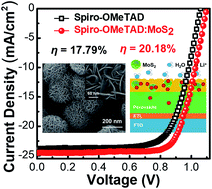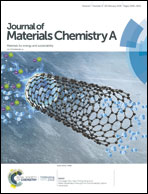Flower-like MoS2 nanocrystals: a powerful sorbent of Li+ in the Spiro-OMeTAD layer for highly efficient and stable perovskite solar cells†
Abstract
2,2,7,7-Tetrakis-(N,N-di-p-methoxyphenylamine)9,9-bifluorene (Spiro-OMeTAD) is a widely employed hole-transporting layer (HTL) in typical n-i-p structure perovskite solar cells (PSCs). And the p-type dopants of bis(trifluoromethane)sulfonimide lithium salt (Li-TFSI) and tert-butylpyridine (tBP) have to be utilized to improve the hole mobility and film conductivity of Spiro-OMeTAD. However, the incorporation of these additives will cause the issue of deliquescence, strongly speeding up the degradation of the Spiro-OMeTAD layer and thus of the perovskite layer. Herein, we developed a modified Spiro-OMeTAD layer using MoS2 with the 2H semiconducting phase and flower-like microstructure. The addition of MoS2 played an important role in improving the hole mobility and enhancing the film stability of Spiro-OMeTAD. The resulting PSCs based on the MoS2-modified Spiro-OMeTAD HTL delivered a champion power conversion efficiency as high as 20.18%. More importantly, the incorporation of MoS2 could suppress the Li+ migration in the HTL owing to the strong adsorption ability and large specific surface area of flower-like MoS2 nanoparticles. As a result, the fabricated PSC without encapsulation exhibited promising stability by retaining almost 85% of the initial PCE even after 300 h exposure to air while the reference device only retained about 30% of its initial PCE.



 Please wait while we load your content...
Please wait while we load your content...